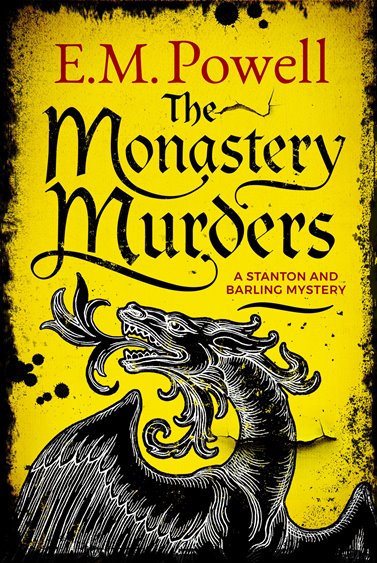A Lot of Work for a Little Snow [GUEST POST]
November 19, 2018 Leave a comment

Whenever we pick up a book by one of our favorite authors, we may not realize just how much research went into writing a certain character, choosing a setting, or crafting a particular scene, especially when the author does her job as seamlessly as historical mystery author, E.M. Powell. Reading her latest novel, The Monastery Murders, she excels at luring us into the story’s disarming setting and made us ask: How did holiday traditions differ way back in 1176 and how does she utilize these details to build suspense? Thankfully she explains in today’s guest post. Enjoy! —J&H

As The Monastery Murders opens on Christmas Eve, I loved this question! It gives me the chance to talk in a bit more depth about part of my research into the novel.
Now, for most historical novelists, our research is a bit like an iceberg. Only a small percentage is visible above the waterline/finds its way onto the page. The rest is submerged and out of sight. But being out of direct sight doesn’t mean that it’s not present in all its vastness. So it was with the holiday setting for Stanton and Barling’s latest case.
I would love to be able to state here that there was a profound reason for setting it at Christmas. But it was a totally pragmatic one: I needed snow for my plot, and lots of it! January is the best month for that here in the UK.
Then I had to decide on specific days for the timeline of the novel. I have an introduction scene to Stanton and Barling where they are attending a bear baiting in London, just before they are called to the first murder. Some readers have commented about how the bear baiting scene really set the tone for the book, but what a difficult read that scene was to read. I can completely understand that, as it was very difficult for me to research and to write.
For those who don’t know, bear baiting was a barbaric sport that was hugely popular in medieval times and continued to be so for many hundreds of years. A bear would be chained to a pit and forced to fight a number of dogs let loose upon it. Bears were extremely valuable and tended to be kept alive to face this terrifying torment over and over again. The dogs faced death as well as mutilation. I wish I could say that this truly horrible spectacle is now firmly in the past, but sadly not. It’s still carried out in many parts of the world, both openly or in illegal fights.
What was important in terms of timing for my novel was that bear baiting was a major spectator sport and took place on feast days. Feast days were literally red-letter days on the medieval calendar, of which more later. They consisted of Easter, Pentecost, Christmas, and Epiphany, along with an elaborate calendar of commemorations and feasts of saints. They were similar to our holidays, in that people were excused from work and ate and drank as richly as they were able and took part in leisure activities. January 1st was celebrated as a feast day. January 1st—New Year’s Day, right? Wrong.
For much of the medieval period, the beginning of the year varied and dates other than January 1st could be used: March 25 (the feast of the Annunciation), Easter (the date of which varied and still does) and 25 December (the Nativity/Christmas). The reason for this was that there were two separate calendars in play. On the one hand was the Julian or Roman calendar, which is very similar to today’s. On the other was the liturgical calendar, which was laid out according to the feasts of the Christian year.
In the liturgical calendar, Christmas is a twelve-day feast. In case you’re thinking the medievals had it easy, think again: the entire season of Advent, in which people prepared for Christmas, was one of fasting. January 1st, the eighth day, was celebrated as the Octave of Christmas, so that worked. My bear baiting was taking place when it should have. When I figured out times for the news of the murder to reach London, it worked out perfectly that Brother Cuthbert had been murdered on Christmas Eve.
And, yes—that was a lot of work to get Stanton and Barling some snow!
ABOUT THE BOOK
Their lives are ones of quiet contemplation—and brutal murder.
Christmas Eve, 1176. Brother Maurice, monk of Fairmore Abbey, awaits the night prayer bell. But there is only silence. Cursing his fellow brother Cuthbert’s idleness, he seeks him out—and in the darkness, finds him brutally murdered.
Summoned from London to the isolated monastery on the Yorkshire Moors, Aelred Barling, clerk to the King’s justices, and his messenger Hugo Stanton, set about investigating the horrific crime. They quickly discover that this is far from a quiet monastic house. Instead, it seethes with bitter feuds, rivalries and resentments. But no sooner do they arrive than the killer strikes again—and again.
When Barling discovers a pattern to these atrocities, it becomes apparent that the murderer’s rampage is far from over. With everyone, including the investigators, now fearing for their lives, can Barling and Stanton unmask the culprit before more blood is spilled?
ABOUT THE AUTHOR
E.M. Powell is the number one Amazon and Bild bestselling author of the Fifth Knight series of historical thrillers, including The Fifth Knight, The Blood of the Fifth Knight, and The Lord of Ireland.
She is also a contributing author to International Thriller Writers’ The Big Thrill magazine, blogs for English Historical Fiction Authors and is the social media manager for the Historical Novel Society.
Born and raised in the Republic of Ireland into the family of Michael Collins (the legendary revolutionary and founder of the Irish Free State), she now lives in northwest England with her husband, daughter, and a Facebook-friendly dog.
The Monastery Murders is the second novel in her Stanton and Barling medieval murder mystery series. Learn more about Powell and her books at her home on the Web at EMPowell.com, like her on Facebook, and follow her on Twitter and Goodreads.
THE MONASTERY MURDERS
By E.M. Powell
288 pgs. Thomas and Mercer. $15.95
Purchase The Monastery Murders at one of these fine online retailers: Amazon, Barnes & Noble, Books-A-Million, Chapters, and IndieBound.
The Monastery Murders is brought to you in association with Historical Fiction Virtual Book Tours.





